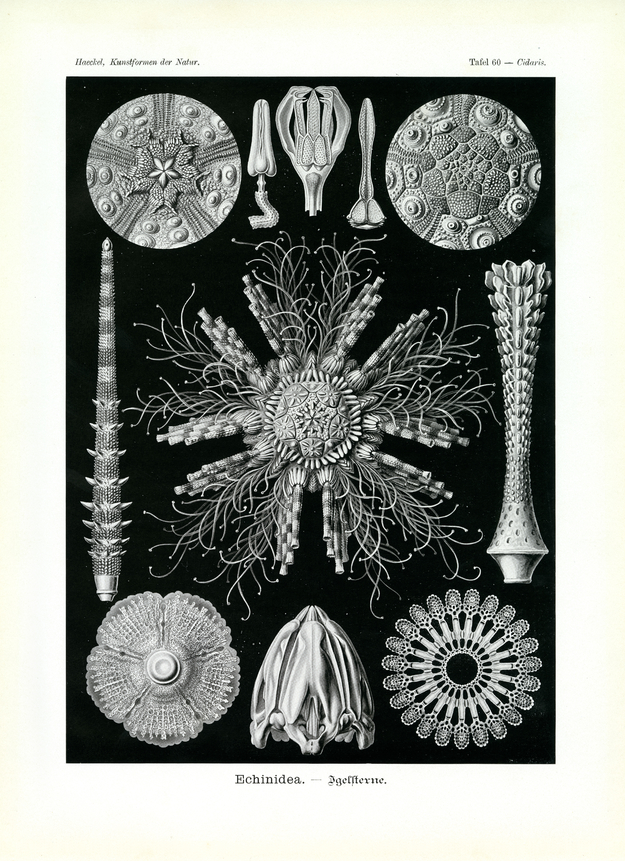Translation of the original German introduction by Ernst Haeckel:
The order of Cidaronia encompasses the older forms of modern urchins with a regularly five-radiant shell, however, they are not at the same time bilaterally symmetrical as in Clypeastronia (plate 30). In all modern urchins the lime shell is composed of twenty meridian rows of panels, running in arch-shape from the upper to the lower pole of the vertical main axis. Two porous (interambulakral) rows of panels alternate regularly with two solid (interambulakral) ones; the former are separated by the main radiant or ‘radiant of first order’ (Perradius), the latter by the intermediate radiant or ‘radiant of second order’ (Interradius). Numerous, very flexible, small feet emerge through the pores of the narrower Ambulakral-panels, carrying one ‘sucking disc’ for suction (fig. 8). The rounded tubercles on the broader Interambulakral-panels are convex ‘joint tubercles’ on which the concave joint areas of flagella move (fig. 1). The flagella are at times slender, bristle-shaped or needle-shaped, at times thick, bar- or club-shaped; many a times they are delicately corrugated, grooved or decorated with ‘thorn-whorls’ (fig. 1, 6 und 7). In profile (fig. 9) the lime flagella show a delicate composition of concentric lamella and radial ribs. In between the flagella, on the outer surface of the shell, most numerous small prehensile claws with two or three arms are seen (Pedicellaria, fig. 4, 5, and 10); they are used for cleansing the external surfaces and for seizing food. The skeleton parts of Pedicellaria show a delicate grill structure, so do the lime panels that serve as support of the ‘suction feet’(fig. 8).
While the biggest part of the urchin shell composes a rigid, inflexible shell capsule, in the centre of the base the ‘mouth field’ with flexible soft skin is found (fig. 2) as well as the ‘anus field’ in the upper centre (fig. 3). The latter comprises of the small anus opening and is surrounded by ten bigger lime panels. Out of these five perradial panels (Ocellar ‘panels’) are smaller and carry an eye; fine interradial panels (Genital ‘panels’) are bigger in size and have a vent. One of these five ‘sexual panels’ (the lower one in fig. 3) is bigger than the other four; it presents a porous filter and serves as so-called Madreporen-‘panel’ for the filtration of seawater that enters the water vessels from outside. In the centre of the ‘mouth field’ (fig. 2) the mouth is armed with five interradial teeth; their locomotion is provided by an internal, complicated ‘chewing apparatus’, the “Lantern of Aristotle” (fig. 11). The pyramid-shaped ‘jaw apparatus’ was already known to Aristotle; it is composed of five large and several small lime pieces.
Translation by VR Translators Bangalore
We've scanned the original lithography at 1200dpi on the Epson A3 scanner of A3 scanner huren. You can download a 400dpi JPEG here.
